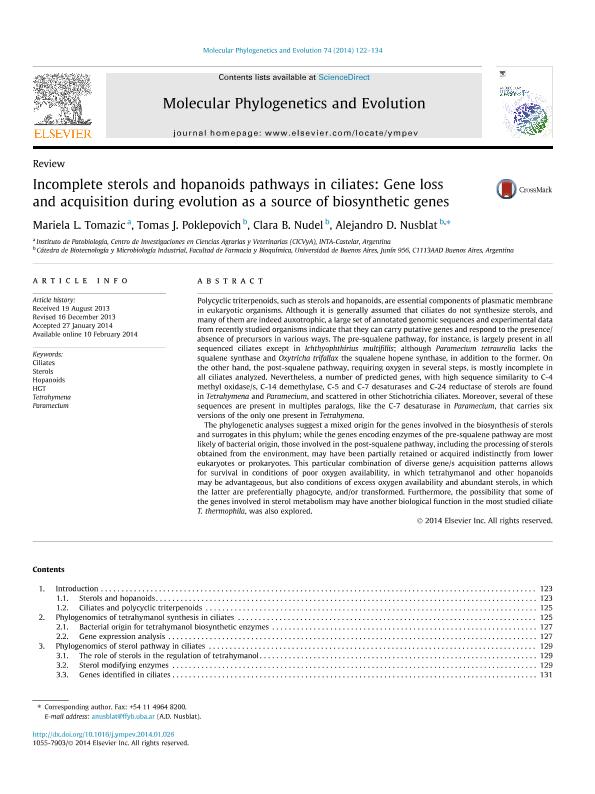Mostrar el registro sencillo del ítem
dc.contributor.author
Tomazic, Mariela Luján

dc.contributor.author
Poklépovich Caride, Tomás Javier

dc.contributor.author
Nudel, Berta Clara

dc.contributor.author
Nusblat, Alejandro David

dc.date.available
2017-05-15T21:36:10Z
dc.date.issued
2014-01
dc.identifier.citation
Tomazic, Mariela Luján; Poklépovich Caride, Tomás Javier; Nudel, Berta Clara; Nusblat, Alejandro David; Incomplete sterols and hopanoids pathways in ciliates: gene loss and acquisition during evolution as a source of biosynthetic genes; Elsevier Inc; Molecular Phylogenetics and Evolution; 74; 1-2014; 122-134
dc.identifier.issn
1055-7903
dc.identifier.uri
http://hdl.handle.net/11336/16517
dc.description.abstract
Polycyclic triterpenoids, such as sterols and hopanoids, are essential components of plasmatic membrane in eukaryotic organisms. Although it is generally assumed that ciliates do not synthesize sterols, and many of them are indeed auxotrophic, a large set of annotated genomic sequences and experimental data from recently studied organisms indicate that they can carry putative genes and respond to the presence/absence of precursors in various ways. The pre-squalene pathway, for instance, is largely present in all sequenced ciliates except in Ichthyophthirius multifiliis; although Paramecium tetraurelia lacks the squalene synthase and Oxytricha trifallax the squalene hopene synthase, in addition to the former. On the other hand, the post-squalene pathway, requiring oxygen in several steps, is mostly incomplete in all ciliates analyzed. Nevertheless, a number of predicted genes, with high sequence similarity to C-4 methyl oxidase/s, C-14 demethylase, C-5 and C-7 desaturases and C-24 reductase of sterols are found in Tetrahymena and Paramecium, and scattered in other Stichotrichia ciliates. Moreover, several of these sequences are present in multiples paralogs, like the C-7 desaturase in Paramecium, that carries six versions of the only one present in Tetrahymena. The phylogenetic analyses suggest a mixed origin for the genes involved in the biosynthesis of sterols and surrogates in this phylum; while the genes encoding enzymes of the pre-squalene pathway are most likely of bacterial origin, those involved in the post-squalene pathway, including the processing of sterols obtained from the environment, may have been partially retained or acquired indistinctly from lower eukaryotes or prokaryotes. This particular combination of diverse gene/s acquisition patterns allows for survival in conditions of poor oxygen availability, in which tetrahymanol and other hopanoids may be advantageous, but also conditions of excess oxygen availability and abundant sterols, in which the latter are preferentially phagocyte, and/or transformed. Furthermore, the possibility that some of the genes involved in sterol metabolism may have another biological function in the most studied ciliate T. thermophila, was also explored.
dc.format
application/pdf
dc.language.iso
eng
dc.publisher
Elsevier Inc

dc.rights
info:eu-repo/semantics/openAccess
dc.rights.uri
https://creativecommons.org/licenses/by-nc-nd/2.5/ar/
dc.subject
Ciliates
dc.subject
Hopanoids
dc.subject
Sterols
dc.subject
Hgt
dc.subject
Paramecium
dc.subject
Tetrahymena
dc.subject.classification
Biología

dc.subject.classification
Ciencias Biológicas

dc.subject.classification
CIENCIAS NATURALES Y EXACTAS

dc.title
Incomplete sterols and hopanoids pathways in ciliates: gene loss and acquisition during evolution as a source of biosynthetic genes
dc.type
info:eu-repo/semantics/article
dc.type
info:ar-repo/semantics/artículo
dc.type
info:eu-repo/semantics/publishedVersion
dc.date.updated
2017-05-15T14:45:42Z
dc.journal.volume
74
dc.journal.pagination
122-134
dc.journal.pais
Estados Unidos

dc.description.fil
Fil: Tomazic, Mariela Luján. Instituto Nacional de Tecnología Agropecuaria. Centro de Investigación en Ciencias Veterinarias y Agronómicas. Instituto de Patobiología; Argentina. Consejo Nacional de Investigaciones Científicas y Técnicas; Argentina
dc.description.fil
Fil: Poklépovich Caride, Tomás Javier. Universidad de Buenos Aires. Facultad de Farmacia y Bioquímica. Departamento de Microbiología, Inmunología y Biotecnología. Cátedra de Microbiología Industrial y Biotecnología; Argentina. Consejo Nacional de Investigaciones Científicas y Técnicas; Argentina
dc.description.fil
Fil: Nudel, Berta Clara. Universidad de Buenos Aires. Facultad de Farmacia y Bioquímica. Departamento de Microbiología, Inmunología y Biotecnología. Cátedra de Microbiología Industrial y Biotecnología; Argentina. Consejo Nacional de Investigaciones Científicas y Técnicas; Argentina
dc.description.fil
Fil: Nusblat, Alejandro David. Universidad de Buenos Aires. Facultad de Farmacia y Bioquímica. Departamento de Microbiología, Inmunología y Biotecnología. Cátedra de Microbiología Industrial y Biotecnología; Argentina. Consejo Nacional de Investigaciones Científicas y Técnicas; Argentina
dc.journal.title
Molecular Phylogenetics and Evolution

dc.relation.alternativeid
info:eu-repo/semantics/altIdentifier/doi/http://dx.doi.org/10.1016/j.ympev.2014.01.026
dc.relation.alternativeid
info:eu-repo/semantics/altIdentifier/url/http://www.sciencedirect.com/science/article/pii/S1055790314000451
Archivos asociados
